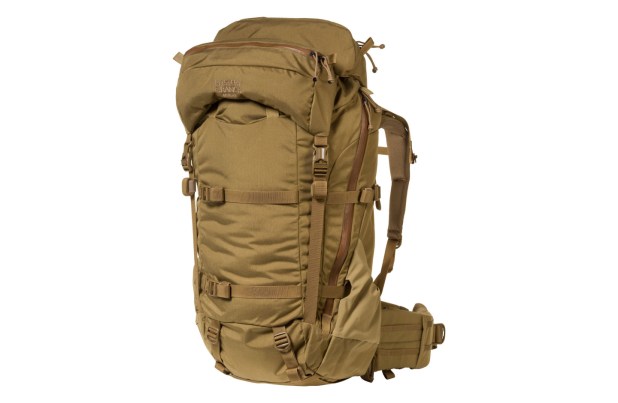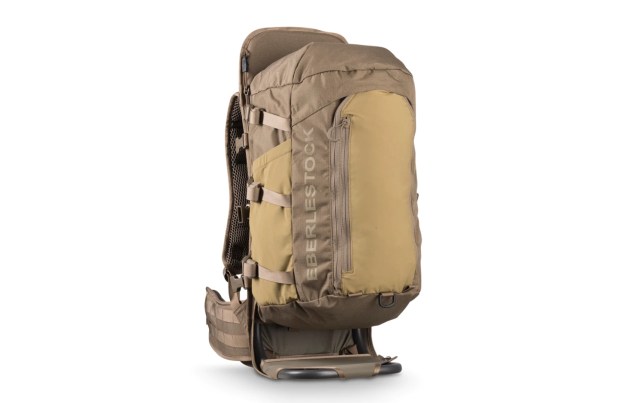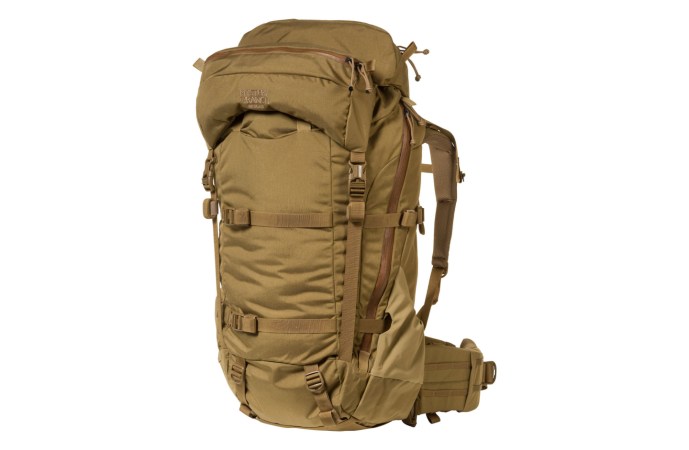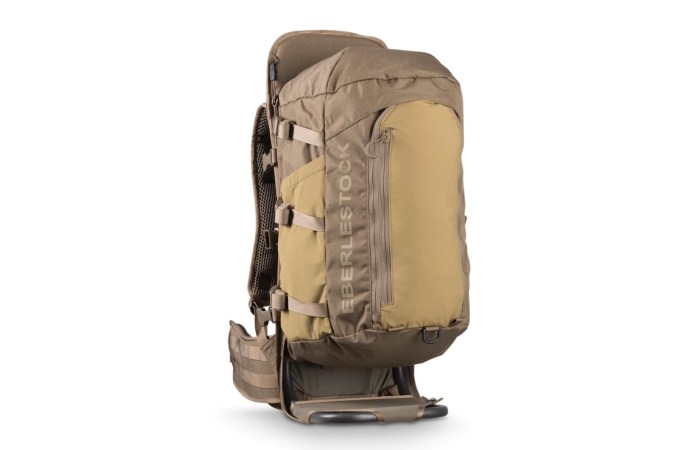We may earn revenue from the products available on this page and participate in affiliate programs.

Light in, heavy out: that’s the way a good hunt goes. Pack in the basics and pack out a truckload of meat. Of course, your truck may be miles away, so a quality hunting backpack is more than just a nicety. That trophy moose isn’t going anywhere unless you pack it all the way back to the truck yourself.
Often, the best game is the hardest to reach. Whether you’re chasing New Mexico elk or the mountain goats of Montana, the best way in is on foot, and what you don’t pack in, you’ll never have on hand. Like hardcore backpackers, dedicated hunters need a dedicated bag to pack in their gear, but unlike hikers, successful hunters will have a harvest far heavier than most backpackers will ever dream of hauling. This makes the best hunting backpacks one-of-a-kind pieces of equipment with plenty of design features no other outdoorsman would ever need.
To that end, we’ve rounded up the best hunting backpacks worth carrying. Take a gander and be ready for your next big hunt.
- Best Overall: Mystery Ranch Metcalf
- Best Value: Cabela’s Multi-Day Hunting Pack
- Editor’s Choice: Eberlestock F1 Mainframe & Vapor 5000
- Best Daypack: Badlands Superday
- Best for Whitetail Deer: Sitka Gear Tool Bucket
Methodology
Hunting backpacks span a wide range of hunt types, so for the sake of simplicity, we focused our search on packs designed specifically for multi-day, backcountry big game pursuits (think Rocky Mountain elk or Alaska moose). That said, we made sure to touch on packs for less strenuous outings, such as a tree stand whitetail hunt.
In addition to looking for quiet, weather-resistant bags, we looked for packs that would endure heavy loads year after year without breaking down. This meant a pack built with tough materials, robust stitching, and a durable weight-bearing frame. We also emphasized wearer comfort, since an awkward, sore spot-inducing backpack is a not-so-great way to cut short the hunt of a lifetime. Weight, cargo capacity, organization, and accessibility also played a significant role in determining a winner.
To make sure we stayed on the right track, we learned from experts with real-world backpack hunting experience. As such, we need to give shoutouts to American Hunter, Backfire, Clay Hayes, Nick Mundt and Michael Waddell via Bone Collector, Eastman’s Hunting Journals, The Element, Emory, By Land, Forgotten Hunter, Ghost Gunners, GOHUNT’s Josh Kirchner and Brady Miller, #Hunt365, The Hunt Journal, Jason Cox, Korbin’s Archery, ProHuntingKnife.com, and ProLiteGear for all their help.
At Task & Purpose, we care about gear, especially backpacks. A good pack could make or break a trip. We’ve written extensively about backpacks for hiking, fishing, and tactical purposes as well as basic carry-on bags. Learn more about what we review and how we review by checking out our editorial guidelines.
Best Overall
Mystery Ranch Metcalf
Best Value
Cabela's Multi-Day Hunting Pack
Editor’s Choice
Eberlestock F1 Mainframe u0026 Vapor 5000
Best Daypack
Badlands Superday
Best for Whitetail Deer
Sitka Gear Tool Bucket
Our verdict on hunting backpacks
Of all the multi-day hunting backpacks on the market, the Mystery Ranch Metcalf is the best all-around solution out of the box with its particular combination of size, capability, and durability. If you’re on a budget, we’ll point you to the Cabela’s Multi-Day Hunting Pack.
What to consider when buying hunting backpacks
Due to the seemingly infinite combinations of hunters, game, and hunting styles, hunting backpacks bear an almost overwhelming range of features and form factors (not to mention colors/patterns and price points). To narrow down your options into a manageable number, pay attention to what type of pack you need and what kinds of features you do (and don’t) need.
Types of hunting backpacks
Daypack
Easily the cheapest and most common type of hunting backpack, daypacks are an often-overlooked piece of gear. Many hunters pick up a cheap pack from their local big box store with the idea that as far as daypacks are concerned, a backpack is a backpack when nothing could be further from the truth.
As with their larger brothers, a well-designed daypack includes everything you need and nothing you don’t. The added features, such as a hydration reservoir pouch or secure bow storage, may add a bit to the price tag, but the functionality will pay off.
While most hunting backpacks are designed for big game hunts, daypacks tend to be much more versatile. Usually, daypacks fall into the 1,000- to 2,500-cubic-inch range (15 to 40 liters).
Overnight pack
A bit larger than hunting daypacks, overnight backpacks can be a sweet spot for many hunters. Typically, an overnight bag’s cargo capacity falls somewhere between 1,500 and 3,000 cubic inches (25 and 50 liters), and customarily, they sport compression straps to help streamline lighter loads.
In addition to extra cargo space, these backpacks sport other valuable features. At this point, heavy loads become a more significant consideration, so pack frames, load suspensions, and meat shelves start making regular appearances.
More gear also necessitates a greater need for easier access and better organization. Besides more pockets, pouches, and sleeves, gear-specific add-ons start to become common fare, such as a spotting scope pocket.
Multi-day pack
Multi-day packs are the most specific form of hunting backpack. Like a traditional backpacker’s backpack, these hunting packs cut every possible ounce from their design while providing extra toughness and add-ons designed specifically for the unique challenges and rigors of backcountry big game hunting.
These packs often range from 2,500 to 6,000 cubic inches (40 to 100 liters), although even larger backpacks are available for diehards. Easily, the most obvious difference between a traditional backpacking pack and a hunting-specific pack is a meat shelf and (usually) a movable bag that allows hunters to secure meat bags between the pack’s frame and the gear-loaded main compartment. Sometimes, rifle and bow scabbards or boots also show up.
Key features of hunting backpacks
Comfort
Spending all day or multiple days in the woods with a pack on your back can be physically demanding, so a comfortable backpack is not optional. As with any bag designed to carry hefty loads, start by looking for a lightweight hunting backpack that fits you well.
All quality packs include features designed to provide a custom fit for maximum comfort. Features such as padded shoulder straps, padded hip belts, and sternum straps are must-haves, and well-ventilated straps, belts, and back panels will reduce your scent in the field.
Proper weight distribution is essential, especially for multi-day backcountry hunts. A quality pack will include some sort of suspension system. In this department, most manufacturers opt for a load-bearing frame, load lifters, and a beefy hip belt. (When selecting a frame-equipped backpack, look for the frame that will fit your torso, and don’t hesitate to contact the manufacturer with any sizing questions.)
Organization and accessibility
Easily accessing your gear in the field can make the difference between a good hunt and a bad one. Look for a hunting pack with enough pockets and pouches to store your gear in easy-to-reach locations. This may mean looking for a bag with gear-specific pockets, but it doesn’t always.
While not a must-have for everyone, a hydration reservoir pouch is a wise investment for most, keeping your gear dry. Smaller external pockets, hip belt pockets, and bow/rifle carriers can be extremely valuable, as can glove-friendly zipper pulls.
Cargo capacity
A hunting backpack’s primary purpose is to store your gear and, if you’re lucky, your meat. Make sure to snag a pack with enough space for your stuff, but avoid buying a bag that’s too big, as human nature is to fill up space with gear just because there’s space.
Most modern backpacks have cargo capacity calculated in liters, but hunters are old-school and (usually) measure their packs in cubic inches. (Here’s a handy cubic inches-to-liters conversion calculator for you.) Cargo capacities vary dramatically from daypacks to multi-day backcountry packs, so look for a backpack that will fit your specific needs. Most backcountry hunters will want a meat shelf as well.
Construction
Like pickup trucks, hunting backpacks are built to work hard. Function and durability reign supreme which makes build quality the kingmaker. Weight and weatherproofing also matter, although not quite as much. (While pack weight is a critical consideration, it should never be the end-all-be-all, as every ounce cut is a potential cut to quality and performance.)
Packs that use YKK zippers, double (or triple) stitching, triple-stitched reinforcements, and high-end materials are worth a close look. The best pack materials are incredibly tough (rip-, scratch-, and abrasion-resistant), weather-resistant (or weatherproof), and quiet. Also, find out if the manufacturer really backs its gear; and pay attention to warranties, especially for high-dollar packs.
Pay attention to a pack’s weatherproofing. Features like snow collars and included rain covers provide an extra layer of protection against the elements, and at higher price points, they may indicate a higher degree of build quality (although not necessarily).
Pricing
When it comes to pricing, it makes the most sense to break things down by pack type. As expected, higher quality comes with a steeper price tag, but as with most things, you get what you pay for.
- Daypacks: Daypacks usually cost less than $250, although the best packs will run at least $150. Frameless packs are relatively common, especially for tree stand hunters.
- Overnight packs: Mid-tier hunting backpacks usually start out in the $200 to $300 range, although high-end packs can easily hit $400 to $500.
- Multi-day packs: If you plan to skip motorized vehicles and pack animals in favor of a miles-long hike into and out of the backcountry, be prepared to drop a bare minimum of $200. Lighter, tougher, and better-organized packs will easily run you $500 to $700 (or more), but the comfort, durability, and functionality are worth the cash for diehard backcountry hunters.
Tips and tricks
As with something you do for decades upon decades, you pick up a few tips and tricks along the way in terms of selecting the right product, and/or using it. That’s the case with us and hunting backpacks. To help you bridge the information gap, here’s a selection of what we’ve learned along the way.
- Not sure what size backcountry pack to get? Go with a medium-size pack with a cargo volume between 3,500 and 5,000 cubic inches (60 and 80 liters).
- Find a backpack that fits your packing style. If you’re unsure of your packing style, consider how you pack for camping or air travel and pick a bag with corresponding external and internal pockets.
- Found a pack you like? Try it before you buy it. Rent it. Borrow your buddy’s. Adjust it to your body and load it up to see how it fits and works in the field.
FAQs about hunting backpacks
You’ve got questions, Task & Purpose has answers.
Q: Why do I need a hunting backpack?
A: Try stuffing enough gear, food, ammo, shelter, and other equipment for a three-day elk hunt into your hunting pants pockets, and you’ll get your answer. If things go your way, you’ll quickly realize that elk quarters aren’t exactly pocket-sized.
Q: What size hunting backpack should I get?
A: For cargo capacity, the “right size” hunting backpack varies from hunter to hunter and from hunt to hunt. When in doubt, figure about 1,000 cubic inches per day.
The “right size” backpack frame depends on your torso size. To determine your torso size, check out this video. When in doubt about pack sizing, contact the manufacturer.
Q: Which frame should I choose?
A: Hunting backpack frames are not interchangeable across brands. If you want an Eberlestock pack, then get the (correct) Eberlestock frame.
Q: Why do some backpacks have a hip belt?
A: Hip belts, especially in conjunction with load lifters or other suspension systems, do an excellent job of redistributing weight away from the shoulder to one of the body’s best load-bearing structures, closer to your center of gravity. This makes heavy loads more comfortable and improves stability while on the move.
Q: What should I pack in my hunting backpack?
A: What kind of game are you hunting and how long do you plan to stay in the field? Besides a first aid kit, food, water, lighting, and emergency survival gear, your packing list will heavily depend on how you answer those two questions.
Q: How do I clean and wash my hunting backpack?
A: Follow the manufacturer’s cleaning instructions printed on the tag. It may not feel manly, but it could save you hundreds.
Q: How do I adjust my hunting backpack?
A: Start with all the pack’s straps loosened. Center your hip belt on the top of your hip bone (iliac crest) and tighten the straps. Next, snug up (but don’t overtighten) the shoulder straps, load lifters (on top of the shoulder straps), and sternum strap. Click here for a visual rundown.







